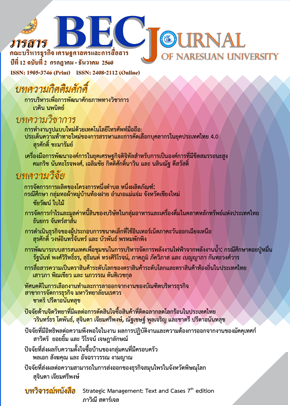การทำงานรูปแบบใหม่ด้วยเทคโนโลยีโทรศัพท์มือถือ: ประเด็นความท้าทายใหม่ของการสรรหาและการคัดเลือกบุคลากรในยุคประเทศไทย 4.0
Main Article Content
บทคัดย่อ
บทความนี้มีวัตถุประสงค์เพื่อวิเคราะห์ให้เห็นถึงทิศทางและแนวโน้มของการทำงานรูปแบบใหม่ ซึ่งเป็นประเด็นความท้าทายใหม่ของการสรรหาและการคัดเลือกบุคลากรในยุคประเทศไทย 4.0 ตลอดจนการเพิ่มผลผลิตให้แก่องค์การโดยการใช้เทคโนโลยีโทรศัพท์มือถือ และนำเสนอแนวทางในการสรรหาและการคัดเลือกบุคลากรภายใต้การทำงานรูปแบบใหม่ด้วยเทคโนโลยีโทรศัพท์มือถือ ซึ่งจะเป็นแนวทางสำคัญให้กับผู้บริหาร ที่ปรึกษาด้านการบริหารทรัพยากรมนุษย์ รวมถึงนักบริหารทรัพยากรมนุษย์ขององค์การต่างๆ ในการสร้างความตระหนักในแง่ของการใช้ประโยชน์จากเทคโนโลยีโทรศัพท์มือถือ (Mobile Technology) ในการเสาะแสวงหาและการได้มาซึ่งบุคคลที่มีความรู้ ทักษะ สมรรถนะ คุณภาพ ตลอดจนมีคุณสมบัติที่เหมาะสมที่สุดจากกลุ่มบุคคลที่มาสมัครงานให้เข้ามาทำงานในตำแหน่งงานที่องค์การต้องการในอันที่จะเสริมสร้างขีดความสามารถทางการแข่งขันให้กับองค์การทั้งในระยะสั้นและในระยะยาว เพื่อให้สอดรับกับรูปแบบและวิธีการทำงานใหม่ในยุคประเทศไทย 4.0
Article Details
เอกสารอ้างอิง
2. Barcelos, K. (2017). Five mobile technologies recruiters need to watch in 2017. Retrieved March 15, 2017, from https://good.co/blog/five-mobile-technologies-recruiters-need-watch-2017/
3. Bean, S. (2015). Number of mobile workers in US will exceed 105 million by 2020. Retrieved March 15, 2017, from http://workplaceinsight.net/us-mobile-workers-will-surpass-105-million-by-2020/
4. Bersin by Deloitte. (2014). Bersin by deloitte research: Strategic onboarding can help new hires “get off on the right foot” and provide an on-ramp to Long-term employee success. Retrieved March 15, 2017, from http://www.bersin.com/News/Content.aspx?id=18012
5. Broughton, A., Beth, F., Stefanie, L. and Annette, C. (2013). The use of social media in the recruitment process. Brighton: Institute for Employment Studies.
6. Changthong, C. (2014). Mobile technology and information services: Perception of users. Journal of Humanities, 16(2), 1-9.
7. Chumchu, P. (2016). Cell phone... over come 3G/4G. Retrieved March 15, 2017, from http://www.mut.ac.th/uploaded/%20......%20กว่าจะมาถึง%203G4G.pdf
8. Dewar, J. (2016). How to optimize your career pages for recruiting success. Retrieved March 15, 2017, from https://www.lever.co/blog/how-to-optimize-your-career-pages-for-recruiting-success
9. Digital Economy Promotion Agency. (2017). 7 major trends of future work. Retrieved March 15, 2017, from http://www.depa.or.th/th/article/7
10. Harcourt, K. (2016). HR turn to content market to attract talent. Retrieved March 15, 2017, from http://blog.mcquaig.com/hr-turns-to-content-marketing-to-attract-talent
11. HireVue. (2017). Benefits of digital interviewing. Retrieved March 15, 2017, from https://www.hirevue.com/solutions/digital-interviewing
12. Jamie, L. P., Karen, L. P., Daniel, R. R. and Robert, M. (2010). How mobile technology is changing our culture. Conference on Information Systems Applied Research Nashville Tennessee, USA, 2010 CONISAR Proceedings, 1-10.
13. Kamkaew, T. (2014). The study of satisfaction of employees using Apple applications to receive order via smart phone: Case study of seoul restaurant in Chonburi province. Master thesis, M.B.A., Bangkok University, Bangkok.
14. Klubsri-on, P. (2015). Key success factors of e-recruitment. BU Executive Journal, 35(1), 114-125.
15. Malaithong, T., Maneechote, M. and Poonmak, P. (2016). Digital economy development for the future countries. Journal of Economic and Social: JESX, 53(2), 11-24.
16. Mayisela, T. (2013). The potential use of mobile technology: Enhancing accessibility and communication in a blended learning course. South African Journal of Education, 33(1), 1-18.
17. Mourapong, W. (2012). Open the door to new ways of working with mobile technology. TPA news, 16(188), 8-9.
National Statistical Office of Thailand. (2015). The survey on the using of information technology and household communication in 2015. Bangkok: National Statistical Office of Thailand.
18. Nation TV. (2016). 90% of 61 Thai people will use smartphone. Retrieved March 15, 2017, from http://www.nationtv.tv/main/content/economy-business/378485613/
19. Office of the Civil Service Commission (OCSC). (2014). Proactive recruitment. Bangkok: Office of the Civil Service Commission (OCSC).
20. Pact, I. (2014). Mobile technology handbook. Washington, DC: Pact Inc.
21. Phumeechanya, N. (2014). Mobile service for smart campus. Journal of Vocational and Technical Education (JVTE), 4(7), 34-42.
22. Polycom. (2015). Top 7 trends in workplace collaboration. Retrieved March 15, 2017, from http://www.polycom.com/content/dam/polycom/common/documents/whitepapers/7-trends-workplace-collaboration-white-paper-engb.pdf
23. Raktham, T. (2016). Trends for hotel technology in 2017. Retrieved March 15, 2017, from https://smartfinder.asia/th/hotel-technology-trend-2017/
24. Rothwell, W. J. (2015). Organization development fundamentals: managing strategic change. Verginia: ATD Press.
25. Saksri, W. and Siripruchyanan, M. (2003). Third generation mobile technology. Journal of Technical Education Development, 14(42), 52-56.
26. Uldrich, J. (2014). Revolutionizing the future workplace. Retrieved March 15, 2017, from http://jackuldrich.com/wp-content/uploads/2014/11/Jack-Uldrich-White-Future-of-Work.pdf
27. Vlad, K., Iris, J. and Douglas, S. (2015). The mobile agility framework: An exploratory study of mobile technology enhancing organizational agility. Journal of Theoretical and Applied Electronic Commerce Research, 10(3), 1-17.


